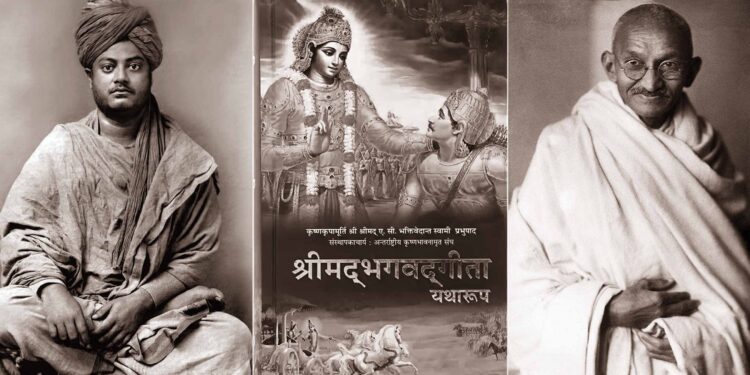There is no doubt that Hindu Dharma or Vendanta received its biggest historical boost when Swami Vivekananda visited Chicago and impressed his audience with his speech at the World’s Parliament of Religions in 1893.
Of all the historical places that one can visit in the West, the Art Institute of Chicago on Michigan Avenue is probably the one that Hindus are most proud of. In fact, the stage on which Swami Vivekananda spoke allows visitors the opportunity to stand on the location where Hindu Dharma first attained some attention and respect from the West. A plaque outside Fullerton Hall reminds us of the words that preceded standing ovations and which replaced the customary opening “ladies and gentlemen” with SISTERS AND BROTHERS OF AMERICA. And following the salutation of Sita-Ram the female gender was first.
It was the 9/11 of the East that advocated peace and unity, not one of violence even though the media still do not see fit to limit the 2001 date to the infamous destructive hateful acts that brought down buildings and took thousands of lives of people of all religions, races and nationalities in New York.
However, it must be recalled that practitioners of the most ancient system of achieving Moksha started arriving in the West by large numbers since May 5, 1838. On this memorable date two ships Whitby and Hesperus landed in then British Guiana (Guyana) with a cargo of labourers who survived the trip across the KALA PANI. to replace slaves on the plantations. This experiment in Mauritius in 1834 was successful so the system of Indentureship was copied to then British Guiana and other countries in the Caribbean until 1920. Mahatma Gandhi’s experience in South Africa had convinced him and Congress that this system described as a new form of slavery had to end.
The survival of the principles of Sanatan Dharma depends on those who live by example.
Many still have to learn about these principles even though they were born and educated in the greatest spiritual empire on earth, Bharat.
Consider the education of Mohandas Karamchand Gandhi (Mahatma Gandhi) in his early years and discuss whether it was unique or more widespread. When in England to study law he was exposed to the teachings of the bible but not the wisdom of the Gita. He was a married man at age 13 but promised his mother to observe the Hindu practices of abstaining from meat, alcohol and promiscuity, He felt ashamed and miserable when during his second year two Englishmen persuaded him to read Krishna’s message to Arjuna that has been handed down for all mankind.
It may not be idle speculation that many Hindus wherever they reside may not have read the Gita described by Swami Vivekananda as “a bouquet composed of the beautiful flowers of spiritual truths, collected from the Vedas and the Upanishads.” What is certain is that many in the West who have been exposed to its eternal wisdom have abundant praise for it.
Ralph Waldo Emerson: “it was the first of books; it was as if an empire spoke to us…the voice of an old intelligence, which in another age and climate had pondered and thus disposed of the same questions which exercise us.” Henry David Thoreau: “In the morning I bathe my intellect in the stupendous and cosmogonal philosophy of the Bhagavad-Gita, in comparison with which our modern world and its literature seem puny”.
Whatever one may think of Gandhi and the decisions he had to make in his political life, few can question the fact that once he was exposed to the Gita he tried to live it daily. In the hands of progressive national leaders like Tilak, Aurobindo Ghosh and others who supported the freedom movement, the Gita became a powerful weapon in the fight against British Imperialism.
Those of us who live in the West can make significant contributions to any country not just by paying taxes, obeying just laws, and participating in the political system but by living a lifestyle guided by the universal principles enshrined in this instruction manual. Recent experience with Covid-19 has demonstrated vividly that we cannot flood hospitals which need its limited resources for emergency patients. If Yoga, meditation, exercise, a vegetarian diet and ayurveda lifestyle can result is making space for those who have heart surgery or lifesaving operations it’s an invaluable contribution to society.
The Gita bristles with numerous verses that teach us to avoid lust, anger and greed. Look at the allegations behind any criminal charges or civil disputes and one can easily find numerous situations where one or more of these guidelines were ignored.
The Gita cannot distribute itself. It is the duty of everyone to find a way to get one in each home. (See article in Hindu Vishwa of Jan-March 2010 page 38 for suggestions.)
Since 2009 HMEC USA along with supporters from Canada and elsewhere have been part of the distribution stream for Gita. Many temples and individuals have sponsored copies as they are still the regular meeting place for community activity. Individuals have added this food for the mind to the meals often shared at religious ceremonies recognizing that it is the best gift for any occasion.
The pocket-size edition is unique in that inside the first cover it states quite clearly that the book is in the public domain and no one can claim copyright. In addition, it has a preface and a background so first-time readers can learn about events leading up to the battle field of Kurukshreta, about 100 miles from Delhi where the Kauravas and their cousins, the Pandavas faced each other on the eve of the MAHABARAT war. It is pocket-sized and can even fit in a purse. Best of all no batteries needed to read it under a tree or on a bus, train or plane. The PDF is available free of cost from the writer to any organization to expand the distribution.



![[ Nbc News ] Barbie debuts its first ‘Diwali doll’ ahead of the Hindu festival of lights](https://hinduvishwa.org/wp-content/uploads/2024/10/241003-diwali-barbie-vl-404p-55c7df-75x75.webp)
![[ India Today ] Ohio senator JD Vance thanks wife, a Hindu, for helping him find Christian faith](https://hinduvishwa.org/wp-content/uploads/2024/06/us-senator-jd-vance-reveals-how-his-hindu-wife-usha-helped-him-find-his-christian-faith-image-re-272530504-16x9_0-120x86.webp)









